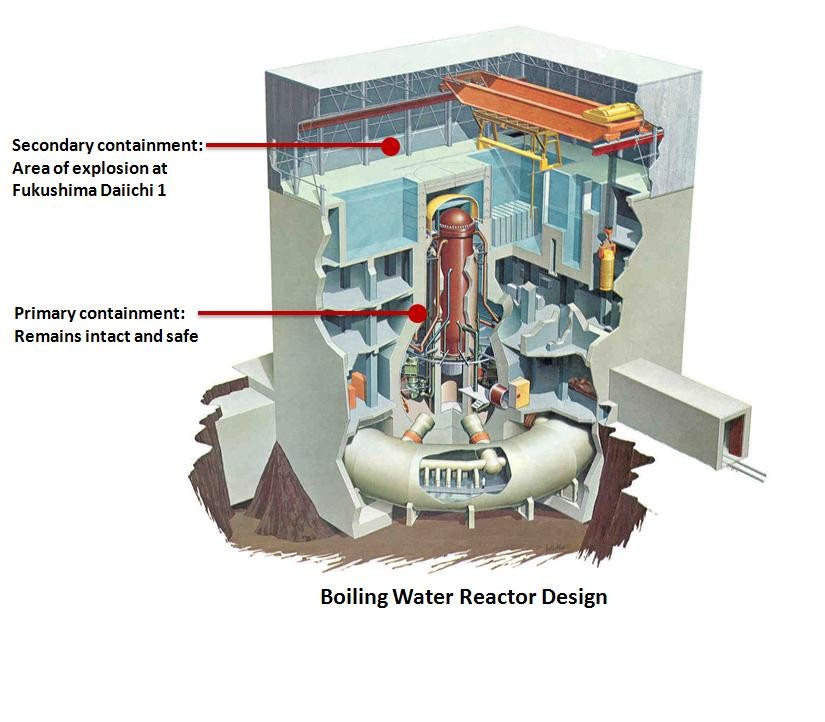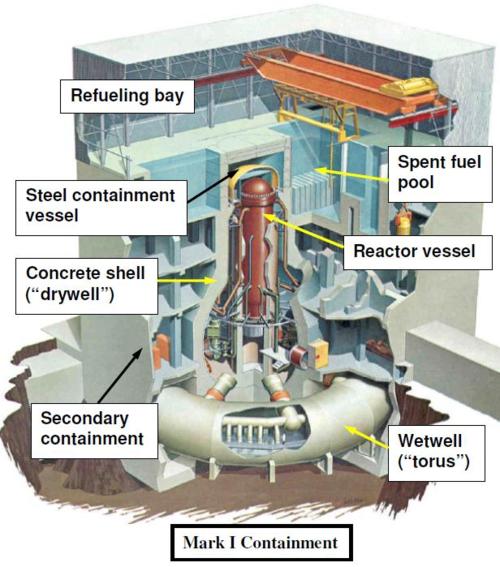博文
关注日本地震东京电力公司核电站泄漏事件
|||


Nuclear energy accounts for 30% of the electricity generated in Japan.


Fukushima #1 (Daiichi) Plant
| Unit | Type | First Criticality | Electric Power |
|---|---|---|---|
| Fukushima I – 1 | BWR | March 26, 1971 | 460 MW |
| Fukushima I – 2 |
BWR | July 18, 1974 | 784 MW |
| Fukushima I – 3 | BWR(MOX) |
March 27, 1976 | 784 MW |
| Fukushima I – 4 | BWR | October 12, 1978 | 784 MW |
| Fukushima I – 6 | BWR | October 24, 1979 | 1,100 MW |


9 = Turbine
13 = cooling system

From Wiki: After the March 11, 2011 earthquake, Nuclear Engineering International reported that units 1 to 3 were automatically shut down, and units 4 to 6 were already in maintenance outages.[2] Diesel generators installed to provide backup power for the cooling systems for units 1–3 were damaged by the tsunami;[3] they started up correctly but then stopped abruptly about 1 hour later.[4] Because cooling is needed to remove residual reactor heat, in Japan a nuclear emergency is declared upon cooling problems and therefore a nuclear emergency was declared—for the first time—when the diesel engines failed. Batteries, which last about eight hours, were being used to power the reactor controls and valves during the electrical outage.[5][6][7] Japanese ground forces were said to be trucking generators and batteries to the site.[8]
Past midnight local time, it was reported that The Tokyo Electric Power Company was considering venting hot gas from the reactor vessel number 1 into the atmosphere, which could result in the release of radiation.[13] The Tokyo Electric Company reported that radiation levels were rising in the turbine building for reactor 1.[14] At 2:00 JST, the pressure inside the reactor was reported to be 600kPa (6 bar or 87 psi), 200 kPa (2 bar or 29 psi) higher than under normal conditions.[4] At 5:30 JST the pressure inside Reactor 1 was reported to be 2.1 times the "design capacity."[15] At 6:10 JST, the IAEA reported that unit 2 was also experiencing cooling problems.[16]
To reduce mounting pressure potentially radioactive steam has been
released from the primary circuit, into the secondary containment.[17] On March 12, 2011 at 6:40 JST,
Chief Cabinet Secretary Yukio Edano stated that the amount of potential
radiation would be small and that the prevailing winds are blowing out
to sea.[18] Measured radiation levels inside the plant control room were reported to be 1000 times greater than normal.[19]
Radiation levels measured at a monitoring post near the plant's main
gate were reported to be more than eight times above normal.[20][21]
In a press release at 7 AM (local) March 12, TEPCO stated "Measurement
of radioactive material (Iodine, etc.) by monitoring car indicates
increasing value compared to normal level. One of the monitoring posts
is also indicating higher than normal level."[12]
不知道这个应急用的柴油发电机,当初设计时有没有考虑到会被海啸给废了?
现在说要加注海水和硼酸的办法来冷却中止核反应,却偏偏遭到又一个大的余震,真是祸不单行。
为什么用氢气做发电机的冷却剂?
Hydrogen is frequently the gas of choice for removing heat from high power generators. Hydrogen has a high heat capacity and, therefore, removes excess heat efficiently. Hydrogen also has a very low viscosity (or windage), thus allowing higher capacity operation of the generators while maintaining efficient cooling.
From Wiki:
The flammability limits (4-75% of hydrogen in air at normal temperature, wider at high temperatures[12]), its autoignition temperature at 571°C, its very low minimum ignition energy, and its tendency to form explosive mixtures with air, require provisions to be made for maintaining the hydrogen content within the generator above the upper or below the flammability limit at all times, and other hydrogen safety measures. When filled with hydrogen, overpressure has to be maintained as inlet of air into the generator could cause a dangerous explosion in confined space. The generator enclosure is purged before opening it for maintenance, and before refilling the generator with hydrogen. During shutdown, hydrogen is purged by an inert gas, then the inert gas is replaced by air; the opposite sequence is used before startup. Carbon dioxide or nitrogen can be used for this purpose, as they do not form combustible mixtures with hydrogen and are inexpensive. Gas purity sensors are used to indicate the end of the purging cycle, which shortens the startup and shutdown times and reduces consumption of the purging gas. Carbon dioxide is favored as due to very high density difference it is easily displaced by hydrogen.
Hydrogen is often produced on-site in electrolyzers, as this reduces the need for stored amount of compressed hydrogen and allows storage in lower pressure tanks, with associated safety benefits and lower costs. Some gaseous hydrogen has to be kept for refilling the generator but it can be also generated on-site.
As technology evolves no materials susceptible to hydrogen embrittlement are used in the generator design. Not adhering to this can lead to equipment failure.
沸水堆简介:Intro to BWR.pdf
核电站安全设计讲究多道设防“Defense-in-depth”,辐射性物质要从核燃料中逃到外界环境,需要经过很多重关卡。这次福岛核电站一号堆发生 氢气爆炸,并让铯137外泄,从目前网上可以搜寻到的信息看,整个事故链,最关键的一环,很有可能竟然是被人忽视的防波墙(seawall)。
地震来临,反应堆自动停堆,电网破坏,失去厂外电源。这个是Design Basis Accident,在设计考虑范围内。按照设计,紧急冷却系统(ECCS)启动,电源由柴油发动机提供。接下来,海啸来临,将柴油发动机毁坏。这个事故估 计在设计考虑范围之外——A Black Swan!此后,备用电池启动,通常只能持续4-8小时。此后,军方似乎提供了移动发电机和电池,未凑效。爆炸前,似乎又出现了一次泵的失效问题。亦有专 家怀疑,有可能在释放解压阀时解压速度太快,导致最后的爆炸。
BWR的安全系统:
BWR的安全系统分主动与被动两类。被动系统从外到里有核安全壳(containment structure),压力壳(Pressure vessel),以及燃料包壳(fuel cladding)以及各种压力管道和设备所形成的被动压力边界(Safety Boundary)。 主动安全系统又分停堆系统和紧急堆芯冷却系统(ECCS)。停堆系统有控制棒(control rods)和堆芯喷芯系统。BWR 的四套ECCS系统:HPCI, ADS, LPCI, LPCS, 其中LPCI属于RHR的一部分功能。

下图(取自NUREG-1032)显示BWR 马克I型核壳电站断电后的事件发展图。资料来源: US NRC G.E. Technology Advanced Manual
t0 = 0, loss of off-plant power and failure of diesel generator
t1 = 6 hours, depletion of DC power; HPCI and RCIC inoperable.
t2 = 8 hours, primary coolant heatup, release of steam; depletion of primary coolant inventory, loss of makeup.
t3 = 10-11 hours, core temperature rises rapidly, resulting in core melt and vessel penetration.
t4 > 11 hours, containment failure occurs nearly coincident with vessel penetration, either by loss of electrical penetration integration or by containment overpressure after high pressure core melt ejection.
也 就是说,根据反应堆安全分析,从柴油机失效开始,大概在11到13个小时内(视电池的工作时间定)如果一直得不到有效外部电源的话,堆芯熔化事件是很有可 能的。不幸的是,在BWR的设计中,这类事故并非设计基准事故(Design Basis Accident, DBA)。原因?PRA分析认为,CCDP在十的负五次方以下。
在福岛,移动发电机在12个小时内送达事故现场,可是不知什么原因,花了很大的力气才续上。

Event Tree for 1989 Brunswick 2, loss of offsite power. Conditional Core Damage Frequency: 3.6E-5.

BWRs have such a large number of motor driven injection systems that a loss of electrical power implies loss of injection capability. This is why, station blackout is consistently identified by PRAs to be the dominant core melt precursor for BWRs. Operators have to be prepared to deal with the effects of a loss of and restoration of ac power to plant controls, instrumentation, and equipment.
Although loss of all ac power is a remote possibility, it is necessary to address the problem both in training of personnel and equipment design.
看来BWR的设计缺陷还是比较明显。
核电站安全设计讲究多道设防或纵深防御 Defense in Depth,有如战役防御,攻破了第一道防线,还有下一道,再下一道,再下一道。
日本的核电站设计,显然是抗震设计的,据说也是抗海啸设计的。但是,抗地震 + 海啸的设计?可能没有。
业内谈Common Cause Risk,同源风险分析,有一段时间了,可是真正实现起来,似乎还有难度。
这么多道安全防线,在同源风险作用下,N = 1. 最后成了马其诺防线,白搭!
更新:
据最新网上信息,备用紧急柴油发动机房竟然是放在厂房的地下室,海啸发生后,海水倒灌,把备用发电机给灭了。工程设计讲一个荷载组合,这次,大地震和大海 啸,两个都是极端事件,设计的时候估计没有想到,这两个极端事件,相关系数等于1!!! 虽然整个安全壳结构本身在强震作用下安然无恙,可是防波墙被轻易地突破了。多道设防成了名副其实的马其诺防线,真是一个血的教训!
如果containment structure比安全壳还坏得早,怎么办?有没有这种可能?如何评估?
>>>>>>>>>>>>>>>>>
update 03/23/2011
中国经济网北京3月24日讯(记者 李雨思 实习生 李方)
中国核电之父欧阳予揭秘真实核电:究竟安不安全欧阳予院士分析说,在这次日本大地震中, 福岛核电站的管道、设备受到强烈地震而断裂、破坏,致使给水送不进反应堆。再加上应急柴油机发电的供油管线也被海啸破坏,致使应急安全注射水的水泵断电而 不能运转,安全注射水注不进反应堆。反应堆堆芯燃料棒失掉冷却而烧坏,乃至熔化,从而发生严重事故。蒸汽管道破裂又使放射性核素碘-131和铯-137等 泄露出去。而堆芯中密封核燃料的锆包壳管,在温度超过400°C后产生锆-水反应,放出大量氢气,氢气泄漏到环境中燃烧,发生化学爆炸,致使某些厂房倒塌。
看来地震本身还是对设备产生的破坏!继续跟踪。
https://blog.sciencenet.cn/blog-103568-421503.html
上一篇:工科概率统计教材应该更新几个新概念
下一篇:21公里之外---核撤退
全部作者的精选博文
全部作者的其他最新博文
全部精选博文导读
相关博文
- • Insects 杰出青年学者奖提名火热进行中
- • Tables of Distinctions and Boundaries Among 4 Spaces(初学者版)
- • Distinctions and Boundaries Among 4 Spaces(初学者版)
- • Mathematical Differences Among 4 Spaces(初学者版)
- • Differences Among 4 Spaces in the DIKWP Mathematics(初学者版)
- • Capabilities of Conceptual Space, Semantic Space, Cogn(初学者版)

